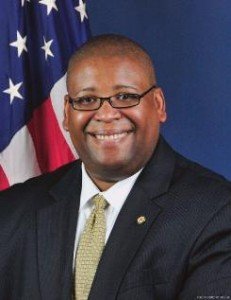The top U.S. auto-safety regulator will step down, as his agency investigates fires in Tesla Motors Inc. electric cars and is behind schedule on implementing a rule requiring backup cameras in new cars.

U.S. National Highway Traffic Safety Administration leader David Strickland won’t leave immediately. His deputy, David Friedman, will serve as acting administrator after Strickland departs, Nathan Naylor, an agency spokesman, said in a phone interview. He declined to say when Strickland will leave or where he is going.
“While several unresolved issues remain on David Strickland’s docket, including the Tesla investigation, he would likely never find a moment where all open cases are resolved,” Karl Brauer, senior analyst at auto-researcher Kelley Blue Book, said in an e-mail.
“The agency has survived changes in leadership before, and it should survive this one without letting anything fall between the cracks,” he said.
The agency is part of the Transportation Department. It regulates safety and fuel economy of passenger vehicles sold in the U.S.
The Environmental Protection Agency said today that average fuel economy of vehicles sold in the U.S. reached a record 23.6 miles per gallon in 2012, the first year of a rule completed before Strickland went to NHTSA.
Strickland, 45, joined the agency in 2010 as it was in the midst of a record number of Toyota Motor Corp. vehicle recalls for defects that could cause unintended acceleration. He announced his departure yesterday at a meeting with top staff. His move was reported earlier by the Detroit News.
Fuel Economy
Strickland was involved in the decision to more than double the required average fuel economy of new cars by 2025. He was also part of former Transportation Secretary Ray LaHood’s effort to curb distracted driving.
Prior to heading NHTSA, he was an aide to the Senate Commerce Committee, where he helped write the law requiring backup cameras in cars. The agency delayed issuing that rule until 2015.
Under his leadership NHTSA has begun work on regulating autonomous vehicles, overseen a test of cars that can communicate wirelessly with each other, and proposed rating passenger vehicles for how well they protect older people.
Strickland, a lawyer, oversaw probes of General Motors Co.’s Chevrolet Volt, after one caught fire in 2011 following a crash test at a NHTSA facility, and of Chrysler Group LLC Jeep Grand Cherokees for risk of fire in rear-end collisions.
Tesla Fires
The Tesla Model S investigation is looking at the risk of fires in lithium-ion batteries following two collisions with road debris that sparked flames. Tesla Chief Executive Officer Elon Musk sought to forestall a federal probe with a software fix. He later posted on his blog that he asked for a NHTSA review, which Strickland denied.
NHTSA earlier this year pressured Chrysler to fix some of the 2.7 million sport-utility vehicles with fuel tanks mounted behind the rear axle after the automaker refused a recall request, saying they didn’t pose a safety risk.
Louis Lombardo, an auto-safety advocate who retired as a NHTSA scientist in 2007, credited Strickland with making the agency more open and transparent even as highway deaths increased last year.
It was the first rise since 2005, with 33,561 people killed on U.S. roads in 2012.
Vehicle Defects
Strickland started with NHTSA shortly before congressional hearings into reports of unintended acceleration in Toyotas. Toyota later agreed to pay a $17.4 million civil penalty for delaying reports of a vehicle defect. Strickland also fined Ford Motor Co., Volvo Car Corp., and Bayerische Motoren Werke AG for recall-related infractions.
The NHTSA administrator post was empty for most of President Barack Obama’s first year in office. Friedman became deputy administrator in May after 12 years at the Union of Concerned Scientists, where he rose to be the deputy director of its clean vehicles program.
Friedman worked opposite automakers as his group helped push for fuel-economy standards that may force manufacturers to more than double their fleetwide averages by 2025.
“He’d make a fine administrator,” Dan Becker, who worked with Friedman as director of the Safe Climate Campaign, said in an interview. “Joan Claybrook, who was the first NHTSA administrator, was an advocate for better safety and for better fuel economy.”
(Editors: Steven Komarow, Robin Meszoly)
Was this article valuable?
Here are more articles you may enjoy.

 Vintage Ferrari Owners’ Favorite Mechanic Charged With Theft, Fraud
Vintage Ferrari Owners’ Favorite Mechanic Charged With Theft, Fraud  MGM Resorts Sues US FTC to Stop Investigation of Casino Hack
MGM Resorts Sues US FTC to Stop Investigation of Casino Hack  Report: Vehicle Complexity, Labor ‘Reshaping’ Auto Insurance and Collision Repair
Report: Vehicle Complexity, Labor ‘Reshaping’ Auto Insurance and Collision Repair  Travelers Survey: Distracted Drivers Making US Roads More Dangerous
Travelers Survey: Distracted Drivers Making US Roads More Dangerous 